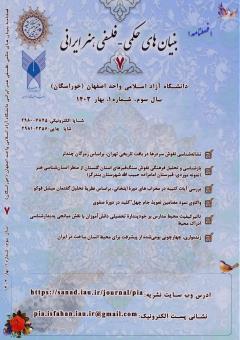زندهواری، چهارچوبی بومیشده از پیشرفت برای محیط انسان ساخت در ایران
محورهای موضوعی : حکمت و معماری
1 - استادیار گروه معماری، واحد اردستان، دانشگاه آزاد اسلامی،اردستان، ایران/مرکز تحقیقات مطالعات آب، واحداصفهان، دانشگاه آزاد اسلامی، اصفهان، ایران
کلید واژه: الگوی پیشرفت, توسعه پایدار, توسعه زندهوار, محیط انسانساخت, معماری زندهوار,
چکیده مقاله :
در ایران مقبولترین چهارچوب پیشرفت جهانی و پایداری، موردپذیرش کامل واقعنشده و لازم است الگویی بومی برای توسعه ارائه شود. پژوهشحاضردر این راستا در ارائه یک چهارچوب بومی پیشنهادی به نام زندهواری گام برداشتهاست. در این پژوهش برای بومیسازیِ نظریۀ توسعه پایدار و دستیابی به چهارچوب زندهواری، از روش ترکیبی دومرحلهای(استدلال منطقی و موردی) استفادهشده است: در مرحلۀ اول با جایگزینی مبانی پایداری با مبانی همارز و مشترک در تفکر و فلسفۀ ایرانی، تفکر سیستمی، فلسفه کاسمونومیک و نظریه ودینگتن از طریق روشی ترکیبی و حکمی اجتهادی، در ابتدا مفروضات و مبانی پارادایم توسعه پایدار بر اساس پارادایمهای فوق تغییر دادهشده و در جهت ایجاد یک مدل ذهنی جدید، پس از بررسی واگرای مفروضات به ترکیب مفاهیم به شکل همگرا و مفروضات نوینی در ارائۀ نظریۀ بومی از زندهواری پرداخته میشود؛ درمرحله دوم، چهارچوب زندهواری باکاربست ومقایسه در نمونههای موردی، مورد سنجشِ بازساخت پذیریِ روراست ونظریهای قرارگرفته تا روند توسعه معماری در لایه های سیاسی، فرهنگی و زیباشناختی توجیه شود و ساختار نظریه تاییدشده در انتها، با روش پیمایشی از طریق تحلیل دلفی کلیت چهارچوب زندهواری سنجیده واز هفت متغیر مورد بررسی، قابلیت زندهواری در مقام یک نظریه بومی با اولویت نخست نیز تایید شد.
The most practical development framework, named sustainability, is not completely accepted in Iran. Therefore, it is necessary to localize the paradigm to adapt to national conditions. In this paper, a new framework named "Zendevari" is derived from sustainable development theory through logical argumentation to be practical in the context of Iran. Thus, this study attempts to localize the framework for evaluating sustainable architecture and present an Iranian model and framework. The model is then tested using one of the most valid models for evaluating architectural sustainability as a quantitative model in the field of architecture. Finally, several successes and examples achieved through the framework are mentioned to confirm the testability and strength of the theory. In this study, a new method is employed to reformulate and form a native Iranian Islamic model, Zendevari, for application in the built environment. The steps and processes of achieving the reconstructions and quantitative patterns are described at the end of this study. Lastly, a mixed method and survey Delphi process, including the Friedman test, confirm Zendevari framework indicators in seven variables, positioning the localized theory in first place.
ایروانی، هوتن، (1389)، تدوین معیارهای کیفی پایداری از طریق مقایسه تطبیقی شهرهای زواره ایران و سانتافه(آمریکا)، رساله دکترای تخصصی معماری، دانشگاه آزاداسلامی واحد علوم وتحقیقات تهران.
خسروپناه، عبدالحسین، (1390)، الگوی حکمی-اجتهادی علوم انسانی، جاویدان خرد، 29-66.
طباطبایی، سیدمحمدحسین، (1399)، اصول فلسفه و روش رئالیسم، صدرا، تهران.
کاظمی، سیدعلیاصغر، (1377)، بحران جامعه مدرن، نشرفرهنگ اسلام، تهران.
گروت، لیندا و وانگ، دیوید، (1401)، روشهای تحقیق درمعماری، ترجمۀ علیرضا عینیفر، دانشگاه تهران، تهران.
متحد، ملل، توسعۀ پایدار، بازیابی از سازمان ملل متحد: http://www.sustainabledevelopment.un.org،8/6/1399.
مصلح، علی اصغر، (1392) ادراکات اعتباری علامه طباطبایی وفلسفه فرهنگ، موسسۀ فرهنگی هنری پگاه روزگارنو، تهران.
Basden, A (1998, May 8), Summary of Dooyeweerd's Cosmonomic Philosophy , Retrieved january 16, 2009, from Dooyeweerd Pages: http://www.dooy.salford.ac.uk/summary.html
Brandon, P. S., & Lombardi, P (2011), Evaluating Sustainable Development In The Built Environment, Blackwell, Oxford.
Campbell, S (1996), Green Cities, Growing Cities, Just cities? Urban planning and the contradictions of sustaunable development, APA Journal, 62(3)(summer), 296-311,468.
Carter, R, Martin, J, Mayblin, B, & Munday, M (1984), Systems, Management and Change, Harper & Row Ltd, Open University.
Iravani, H, & Etessam, I (2009), Role of Wind and Natural Ventilation in the Vernacular Architecture of Zavareh, International Journal of Ventilation (ISI), 175-186.
Iravani, H, & Mofidi Sh, S.M (2008), Role of Wind in Vernacular Architecture of Zavareh, Varoius Ventilation Types. Renewable Energy and Environment for Sustainable Architecture (pp. 523-530), Narosa, Delhi.
Iravani, H, Salehi, F., Zamani, N, & Hashemi, E (2018), An Evaluation of Zendeveri (Lifelikeness) in the Architecture of Imam Jome’eh House in Isfahan, International Journal of Architecture and Urban Development, 49-60.
Moore, G (1991), Linking Environment-Behaviour and Design Theories: Framing the Deabate, EDRA, Mexico.
Santa Fe City Code (1997), Retrieved January 10, 2009, from The Official Website of Santa Fe, New Mexico: Sustainable Development Indicators, (1994, JANUARY 20). Retrieved 2010, from WWW.UNHABITAT.ORG.
U.N. (1996), Indicators of Sustainable Development: Framework and Methodologies, U.N., New York.
U.N. (2007), Indicators of Sustainable Development, United Nations Publication, New York.
United States Green Building Code (2009), Retrieved MAY 12, 2009, from LEED: http://www.usgbc.org/store/ publicationslist_new.aspx?CMSpageID=1518
Waddington, C (1942), Canalization of development and the inheritance of acquired characters, Nature , 150 (3811):563–565.
WCED, B. C. (1987), Our Common Future, United Nation, New York.


